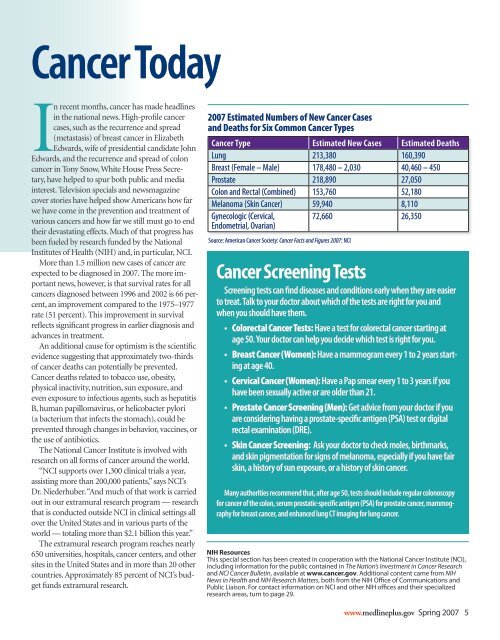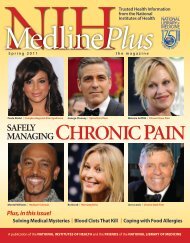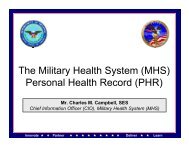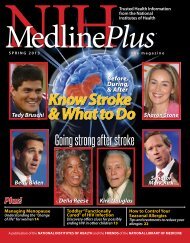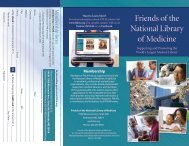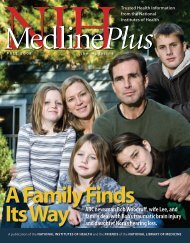Sam Donaldson's cancer survival tips - National Library of Medicine ...
Sam Donaldson's cancer survival tips - National Library of Medicine ...
Sam Donaldson's cancer survival tips - National Library of Medicine ...
You also want an ePaper? Increase the reach of your titles
YUMPU automatically turns print PDFs into web optimized ePapers that Google loves.
Cancer Today<br />
In recent months, <strong>cancer</strong> has made headlines<br />
in the national news. High-pr<strong>of</strong>ile <strong>cancer</strong><br />
cases, such as the recurrence and spread<br />
(metastasis) <strong>of</strong> breast <strong>cancer</strong> in Elizabeth<br />
Edwards, wife <strong>of</strong> presidential candidate John<br />
Edwards, and the recurrence and spread <strong>of</strong> colon<br />
<strong>cancer</strong> in Tony Snow, White House Press Secretary,<br />
have helped to spur both public and media<br />
interest. Television specials and newsmagazine<br />
cover stories have helped show Americans how far<br />
we have come in the prevention and treatment <strong>of</strong><br />
various <strong>cancer</strong>s and how far we still must go to end<br />
their devastating effects. Much <strong>of</strong> that progress has<br />
been fueled by research funded by the <strong>National</strong><br />
Institutes <strong>of</strong> Health (NIH) and, in particular, NCI.<br />
More than 1.5 million new cases <strong>of</strong> <strong>cancer</strong> are<br />
expected to be diagnosed in 2007. The more important<br />
news, however, is that <strong>survival</strong> rates for all<br />
<strong>cancer</strong>s diagnosed between 1996 and 2002 is 66 percent,<br />
an improvement compared to the 1975–1977<br />
rate (51 percent). This improvement in <strong>survival</strong><br />
reflects significant progress in earlier diagnosis and<br />
advances in treatment.<br />
An additional cause for optimism is the scientific<br />
evidence suggesting that approximately two-thirds<br />
<strong>of</strong> <strong>cancer</strong> deaths can potentially be prevented.<br />
Cancer deaths related to tobacco use, obesity,<br />
physical inactivity, nutrition, sun exposure, and<br />
even exposure to infectious agents, such as hepatitis<br />
B, human papillomavirus, or helicobacter pylori<br />
(a bacterium that infects the stomach), could be<br />
prevented through changes in behavior, vaccines, or<br />
the use <strong>of</strong> antibiotics.<br />
The <strong>National</strong> Cancer Institute is involved with<br />
research on all forms <strong>of</strong> <strong>cancer</strong> around the world.<br />
“NCI supports over 1,300 clinical trials a year,<br />
assisting more than 200,000 patients,” says NCI’s<br />
Dr. Niederhuber. “And much <strong>of</strong> that work is carried<br />
out in our extramural research program — research<br />
that is conducted outside NCI in clinical settings all<br />
over the United States and in various parts <strong>of</strong> the<br />
world — totaling more than $2.1 billion this year.”<br />
The extramural research program reaches nearly<br />
650 universities, hospitals, <strong>cancer</strong> centers, and other<br />
sites in the United States and in more than 20 other<br />
countries. Approximately 85 percent <strong>of</strong> NCI’s budget<br />
funds extramural research.<br />
2007 Estimated Numbers <strong>of</strong> New Cancer Cases<br />
and Deaths for Six Common Cancer Types<br />
Cancer Type Estimated New Cases Estimated Deaths<br />
Lung 213,380 160,390<br />
Breast (Female – Male) 178,480 – 2,030 40,460 – 450<br />
Prostate 218,890 27,050<br />
Colon and Rectal (Combined) 153,760 52,180<br />
Melanoma (Skin Cancer) 59,940 8,110<br />
Gynecologic (Cervical,<br />
Endometrial, Ovarian)<br />
72,660 26,350<br />
Source: American Cancer Society: Cancer Facts and Figures 2007: NCI<br />
Cancer Screening Tests<br />
Screening tests can find diseases and conditions early when they are easier<br />
to treat. Talk to your doctor about which <strong>of</strong> the tests are right for you and<br />
when you should have them.<br />
• Colorectal Cancer Tests: Have a test for colorectal <strong>cancer</strong> starting at<br />
age 50. Your doctor can help you decide which test is right for you.<br />
• Breast Cancer (Women): Have a mammogram every 1 to 2 years starting<br />
at age 40.<br />
• Cervical Cancer (Women): Have a Pap smear every 1 to 3 years if you<br />
have been sexually active or are older than 21.<br />
• Prostate Cancer Screening (Men): Get advice from your doctor if you<br />
are considering having a prostate-specific antigen (PSA) test or digital<br />
rectal examination (DRE).<br />
• Skin Cancer Screening: Ask your doctor to check moles, birthmarks,<br />
and skin pigmentation for signs <strong>of</strong> melanoma, especially if you have fair<br />
skin, a history <strong>of</strong> sun exposure, or a history <strong>of</strong> skin <strong>cancer</strong>.<br />
Many authorities recommend that, after age 50, tests should include regular colonoscopy<br />
for <strong>cancer</strong> <strong>of</strong> the colon, serum prostatic-specific antigen (PSA) for prostate <strong>cancer</strong>, mammography<br />
for breast <strong>cancer</strong>, and enhanced lung CT imaging for lung <strong>cancer</strong>.<br />
NIH Resources<br />
This special section has been created in cooperation with the <strong>National</strong> Cancer Institute (NCI),<br />
including information for the public contained in The Nation’s Investment in Cancer Research<br />
and NCI Cancer Bulletin, available at www.<strong>cancer</strong>.gov. Additional content came from NIH<br />
News in Health and NIH Research Matters, both from the NIH Office <strong>of</strong> Communications and<br />
Public Liaison. For contact information on NCI and other NIH <strong>of</strong>fices and their specialized<br />
research areas, turn to page 29.<br />
www.medlineplus.gov Spring 2007 5


